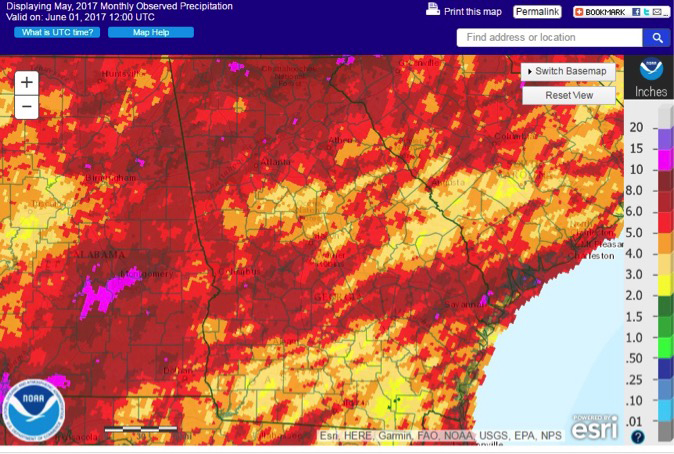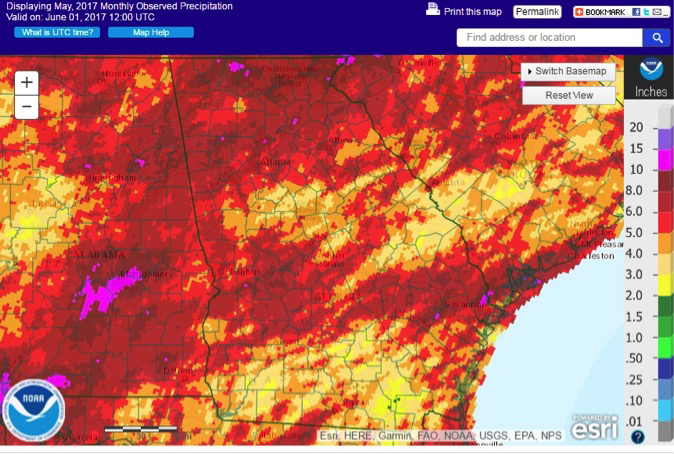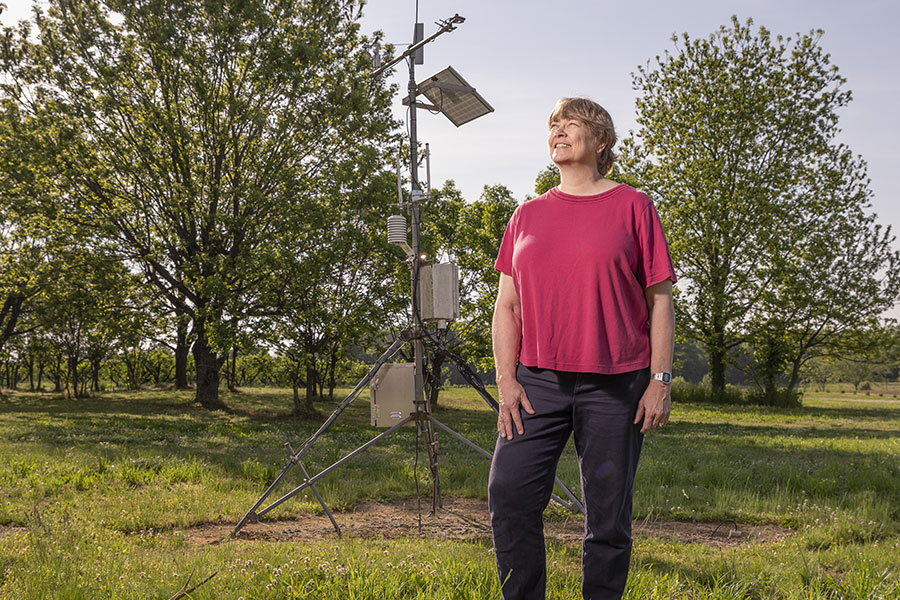May’s warm, wet conditions brought relief to the parched areas of the state, and Georgians can expect more of the same in June.
The rain was welcomed by farmers, but so much rain in such a short period of time delayed planting in some areas and caused erosion and flash-flooding problems.
Almost the whole state received above-normal precipitation in May, except for a few small areas scattered around south Georgia, and even those areas received close-to-normal precipitation.
Savannah, Georgia, set a new daily rainfall record on May 22 with 6.61 inches, smashing the old record of 2.21 inches set in 1967. Athens, Georgia, also set a new daily record on May 21 with 2.42 inches, surpassing the old record of 1.6 inches set in 1888. Brunswick, Georgia, received 1.31 inches on May 24, which broke that city’s old record of 0.91 inches set in 2009.
This was the wettest May in Savannah’s 144-year record, beating out the old monthly record of 11.13 inches set in 1915. It was also the sixth-wettest May for Macon, Georgia, in 121 years.
The highest daily rainfall totals recorded by Community Collaborative Rain, Hail and Snow Network (CoCoRaHS) volunteers were 5.15 and 4.91 inches, both from observers near Pooler, Georgia, in Chatham County. The highest monthly total — 11.92 inches — came from an observer near Villa Rica, Georgia, in Carroll County, followed by 11.28 inches measured near Rincon, Georgia, in Effingham County, and 10.58 inches measured near Acworth, Georgia, in Cobb County.
Savannah had the state’s highest monthly precipitation total for May — 11.54 inches, 8.56 inches above normal, according to National Weather Service stations. The lowest precipitation total came in Valdosta, Georgia — 2.34 inches, 0.19 inches below normal.
- Albany, Georgia, received 3.83 inches of precipitation, 1.14 inches above normal.
- Alma, Georgia, received 3.52 inches of precipitation, 1.05 inches above normal.
- Athens received 6.24 inches of precipitation, 3.24 inches above normal.
- Atlanta received 4.6 inches of precipitation, 0.93 of an inch above normal.
- Augusta, Georgia, received 3.34 inches of precipitation, 0.69 of an inch above normal.
- Brunswick received 4.03 inches of precipitation, 2.07 inches above normal.
- Columbus, Georgia, received 5.37 inches of precipitation, 2.18 inches above normal.
- Macon received 6.07 inches of precipitation, 3.35 inches above normal.
- Rome, Georgia, received 5.91 inches of precipitation, 1.73 inches above normal.
Above-normal temperatures covered most of Georgia in May 2017. All but two National Weather Service offices reported temperatures as much as 3 degrees above normal. May was the 16th month in a row that the state saw above-normal temperatures.
A number of record temperatures were tied or set in May. A daily high temperature record was set in Savannah on May 10, when 95 degrees Fahrenheit surpassed the old record of 94 F set in 1889. Two record highs were tied in Brunswick: a high of 93 F on May 10, originally set in 2003, and a high of 96 F on May 11, set in 1973.
High nighttime temperature records were tied in Savannah on May 21 at 74 F, which matches the old record from 1902, and in Brunswick on May 11 with 71 F, which matches the old record from 1966. Brunswick also broke its high nighttime temperature record on May 1 at 75 F, which beat the old record of 73 F set in 1954.
Low daytime temperature records were also set on May 5 at a number of stations including Atlanta, Athens, Columbus and Macon, with maximum temperatures on that date reaching only the mid-50s. Columbus’ new record of 57 F beat its old record of 66 F set in 1987.
- In Alma, the monthly average temperature was 74.5 F, 0.8 of a degree above normal.
- In Atlanta, the monthly average temperature was 71.1 F, 1 degree above normal.
- In Athens, the monthly average temperature was 70.4 F, 0.4 of a degree above normal.
- In Augusta, the monthly average temperature was 74.1 F, 3 degrees above normal.
- In Albany, the monthly average temperature was 74.5 F, which was neither above nor below normal.
- In Columbus, the monthly average temperature was 73.4 F, 0.4 of a degree above normal.
- In Macon, the monthly average temperature was 71.8 F, 0.1 of a degree below normal.
- In Savannah, the monthly average temperature was 75.5 F, 2.2 degrees above normal.
- In Brunswick, the monthly average temperature was 76.7 F, 2.2 degrees above normal.
- In Rome, the monthly average temperature was 70 F, 1.8 degrees above normal.
- In Valdosta, the monthly average temperature was 73.5 F, 0.3 of a degree below normal.
March frost damage estimates continue to come in — about 80 percent of the peach crop was lost as well as 85 percent of the blueberry crop. Many farmers will not have any fruit to sell outside of the state.
The outlook for June shows that an increased chance of cooler- and wetter-than-normal conditions is likely, particularly in the northern half of the state. Drought is expected to recede in the southern counties, and dry conditions are likely to be eliminated farther north. The summer forecast still shows an increased chance of above-normal temperatures, particularly in the driest areas.
For more information, please see the “Climate and Agriculture in the South East” blog at blog.extension.uga.edu/climate/ or visit www.gaclimate.org. Please email pknox@uga.edu to share your agricultural weather and climate impacts on the blog.




